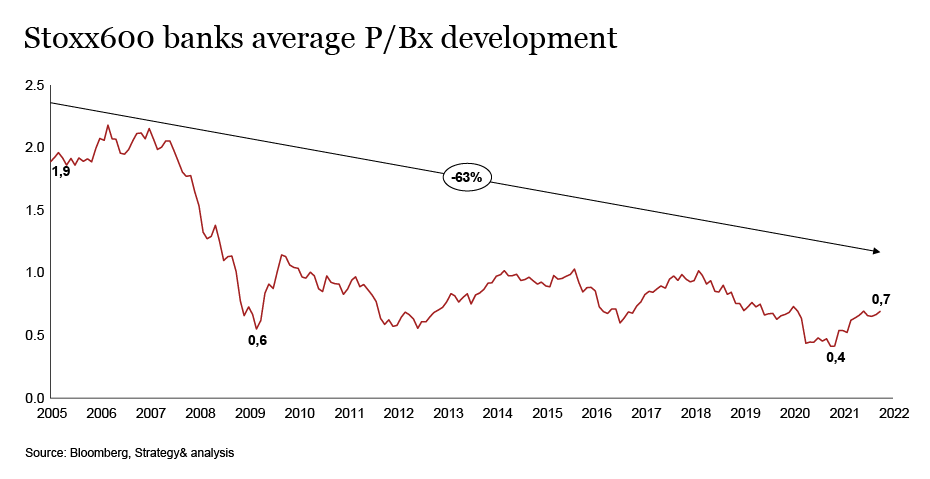{{item.title}}
{{item.text}}

{{item.title}}
{{item.text}}
The last 18 months more prominent M&A activity in Europe’s highly fragmented banking market, led by deals in Spain and Italy. Financial institutions should be laying the groundwork in anticipation of more merger activity.
The case for more consolidation was strong even before the onset of the COVID-19 crisis. For years, Eurozone lenders have struggled to earn returns above their cost of capital. Although share prices have been on a positive track in 2021 recovering from a devastating year 2020, they have lagged the wider market and international peers since the 2008 financial crisis, driven by sagging profitability. A combination of zero or negative interest rates, fragmented markets, rare successes in rigorous cost reduction, and steep competition have all translated into a significant drop in banks’ valuation levels since 2008:
The COVID-19 pandemic has only intensified the pressures on profitability. National governments, the EU, and the European Central Bank (ECB) stepped in with extraordinary measures to shield the economy from the worst of the impact from successive lockdowns.
While most banks recognized the impact of the pandemic on profitability and RWAs, the post-COVID environment is unlikely to offer relief from margin compression across customer segments. Banks will have to radically transform their cost base as part of a wider strategy to address their profitability squeeze and other challenges, including the ongoing threat from fintech and BigTech and implementing effective environmental, social and governance goals. Mergers can ease the pressure by helping to cut costs and achieve scale to better tackle technology investments and become more competitive in certain business lines, in particular in wholesale banking.
The ECB has spelled out its approach to takeovers and publicly reiterated its well-known view that banks should consider cross-border and domestic consolidation. Following a public consultation in 2020, the central bank published a new guide to banking consolidation in January 2021 that provides certainty on how it will assess deals. Among the different technical aspects, two measures stand out and will influence banks’ view on consolidation activity:
The recognition of badwill provides a strong incentive to merge and was used in the recent deals in both Spain and Italy. Intesa Sanpaolo’s takeover of local Italian rival UBI Banca generated €2bn in badwill that was used to cover integration costs and accelerate NPL reduction. In addition, the synergies proved to be higher than initially expected. In the case of Caixabank’s takeover of Bankia, the badwill amounted to €4.3bn.
Given low market valuations in Europe, the potential for badwill is great. Across the European banking market, the gap between the book values of European banks and their market values could be as much as €380bn.
We believe the ideal merger would have strong potential for synergies and generate a high amount of badwill:
Banking mergers in Europe have been scarce in recent years but picked up in the last 18 months. The region is likely to see more deals in the next 12-18 months, as banks repair their capital ratios, transform for the post-COVID world and need to find credible strategies to earn appropriate returns on equity in the future.
In-market consolidation is more likely than cross-border deals since these domestic tie-ups are usually driven by cost-cutting, such as streamlining distribution networks and central functions. They are generally easier to execute since there are fewer structural constraints and regulatory authorities involved. Meanwhile, the obstacles to cross-border mergers remain, including the slow progress toward a full European banking union and regional deposit scheme.
However, while cross-border transactions offer less cost-savings potential, they provide strategic benefit to banks:
These deals are more likely to happen with stronger banks whose domestic markets are already concentrated, and are more likely to be in wholesale rather than retail banking.
When banks are considering potential deals, our experience from working with clients shows there are three key areas to focus on to most likely (or: presumably) achieve a successful outcome:
Timing of the transaction: Deals should ideally be contemplated from a position of strength and minimum market volatility. The weaker the bank, the more likely it will be considered a target in a transaction. Strength can be assessed on several measures, including a bank’s current market valuation, its costs and productivity ratios, capital buffers and loan-book quality, as well as the economic outlook in its domestic market.
Thorough strategic and financial analysis of potential deals with a focus on key technicalities that can alter deal economics. The most critical step of a successful deal is the initial analysis since strategic options are highly dependent on the starting point of each individual bank. During this pre-deal phase, banks often struggle to get key components of the value-creation analysis right. Examples include adjustments that need to be made to the fair value of assets in merger accounting or taxation topics, but also obstacles to synergies in operating expenditures such as labor agreements that can often cause significant swings in the combined profitability forecast and capital levels. The combined capabilities of the merged bank will be the key driver for achieving synergies and requires a thorough analysis pre-deal. These capabilities may be market-oriented (related to increased global market coverage) or operating model-driven (such as ongoing strategic cost management). Our analysis finds that capabilities-driven deals outperform transactions that focus on just taking out costs in the medium to long term.
Efficient execution: Banks must have a strong team in place with clear responsibilities to manage all phases of the deal, from the pre-transaction analysis to the negotiations and post-deal execution. They should be able to follow a tight timeline and manage sensitive negotiations. This includes undertaking commercial due diligence as well as IT and operational due diligence, and any other potential red flags. Finally, the bank should ensure smooth integration with key stakeholders during the deal and integration phase, for example having a clear timeline and organizational structure for employees.
Following deals activity within the last 18 months in some Eurozone countries, the stars are aligning for further consolidation in the banking sector. Though domestic mergers are more likely in the short term, stronger banks may contemplate cross-border tie-ups. Either way, banks considering an active role in consolidation should first undertake a thorough analysis of the potential deal in order to minimize risks and maximize value for stakeholders.





